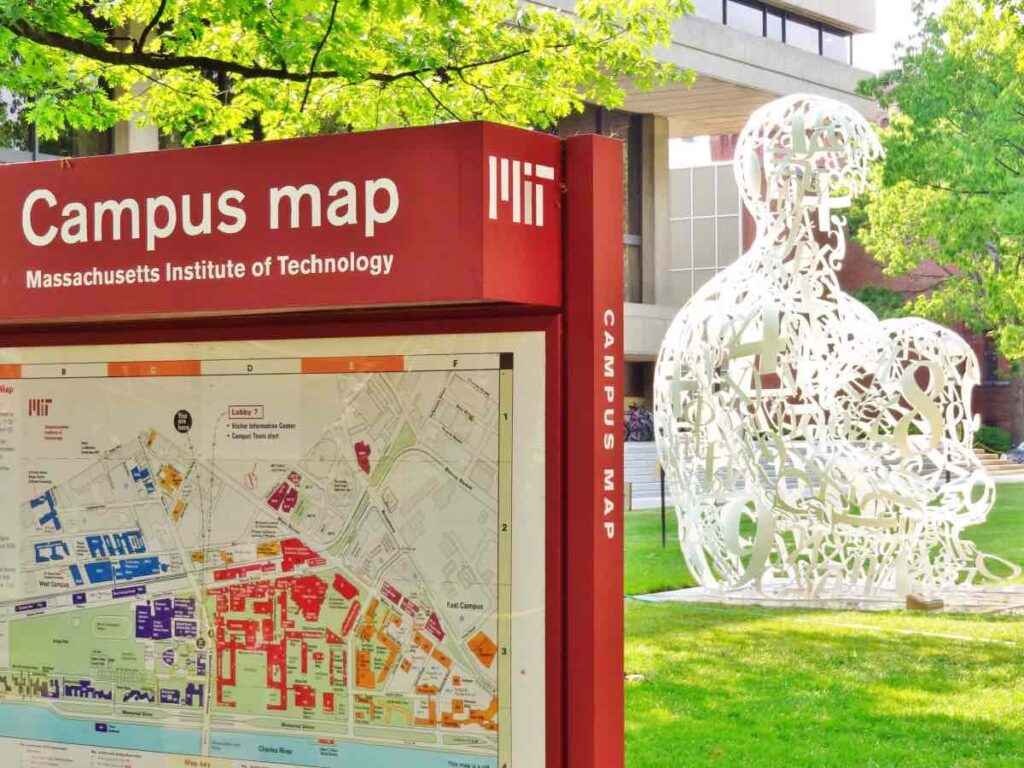1 in 100 – Your Chances to Transfer to MIT – Learn How to Increase
When it comes to undergraduate engineering and STEM-related programs, perhaps none is as popular as the Massachusetts Institute of Technology (MIT). Other than its academic offerings, it’s also known for its selectivity.
Planning on transferring to MIT anytime soon because you are not completely happy with the program at your current school or you failed to get an acceptance letter from it before and taking a gap year was not an option?
I always wondered if it is easier to transfer to MIT than get in as a freshman and here are my findings.

MIT Acceptance Rates: Freshman vs. Transfer Chances
The acceptance rate for first-time, first-year students at MIT is 4%. Meanwhile, the acceptance rate for transfer students at the highly selective school located in Cambridge, Massachusetts is only more than 1%.
In most instances, only approximately 25 students transferring from various colleges and universities are accepted to MIT.
Everyone knows that MIT is one of the most competitive schools out there. Despite this, many still try their luck at getting in, especially those who want to go for some of the best engineering and physical sciences programs in the land.
In the last admissions cycle, for instance, this private research university received a total of 33,796 applications.
Incoming freshmen students, needless to say, have to be above-average high schoolers if they want the highly prominent school to give their applications a chance.
Just like what’s mentioned earlier, it has a low 4% acceptance rate — Harvard University has the same acceptance rate, which is why many students mistake MIT for an Ivy League.
If you think MIT’s acceptance rate for first-time, first-year students is ridiculously low, wait until you hear about its acceptance rate for transfer students: per admissions cycle, the elite school accepts 20-plus hopefuls only.
Doing the math reveals that the school accepts less than 2% of all transfer students.
The university does not provide too much information about transfer successes. Long ago, in 2015, for instance, MIT News itself said that only 19 transferees were accepted.
Some of them included those who previously attended schools such as Bunker Hill Community College, Taras Shevchenko National University of Kyiv, the University of Rochester, Cornell University and Peking University — MIT accepts transferees from various types of higher education institutions.
Meanwhile, a total of 24 applicants with previous college experience in 2021, says a report by Admission Sight. The website added that the following are the transferee acceptance rates in terms of gender:
- Female transferees – 1.9%
- Male transferees – 1.6%
So, yes, a transfer acceptance rate of just more than 1% is crazy low alright, but transfer students still do get into MIT.
Is It Possible to Transfer to MIT From a Community College?
MIT accepts transferees from various types of degree-granting institutions of higher education. It doesn’t matter whether a transfer applicant’s school is private or public or whether it’s a 4-year institution or a state or community college. Provided that the student meets the eligibility requirements, he or she can get accepted to MIT as a transfer student.
Yes, you read that right: there’s no need to come from an equally competitive institution just to be able to get admitted to MIT as a transfer student.
So, in other words, your academic performance is key.

MIT Transfer Sucess Stories
Andrew Sutherland, for instance, was attending a state college when a professor of his, who happened to be an MIT alumni member, urged him to apply to the prominent school where he got accepted.
There’s also Evelyn De La Rosa who got admitted to MIT with the help of a transfer program for community college students called Transfer Scholars Network.
And here’s an almost 4-minute video of a transfer student from China, Guangtao Zhang, who entered MIT as a sophomore student and majored in mechanical engineering, narrating how she experienced anxiety at first knowing how hard the school is.
How to Stand Out in Your MIT Transfer Application
There is no particular profile of student that it looks for, MIT says. However, it does look for applicants who exhibit traits and qualities that would make them a good match for the institution.
Needless to say, it has a preference for academically talented students who also demonstrate community mindedness and engagement.
Because the acceptance rate for transfer students is smaller than the acceptance rate for first-time, first-year students, it’s a must for anyone from another college who plans on transferring to MIT to have a complete standout application.
It’s a good thing that MIT is not looking for a particular type of student.
However, as expected, being a high-performing undergraduate is a must for the elite school’s admissions officers to consider the application of someone with some previous college experience.
It wants someone who would fit perfectly on its campus, such as a student who is interested in an analytical-based, hands-on education.
MIT admits, too, that the students it admits are the kinds with a wide range of interests, activities and experiences. So, in other words, extracurriculars are some of the most important parts of a transfer student’s application.

Who Has the Best Chances of Getting Admitted to MIT?
According to MIT itself, there’s no formula for gaining transfer admission to it. But given that it’s a highly selective institution, it’s for certain that only the most competitive transfer applicants receive an offer to enroll.
For instance, while there’s no minimum GPA transferees need to meet, MIT says that it typically accepts those with a GPA of at least 3.5.
It’s no secret that MIT is one of the most selective universities not only in the US but also all over the planet.
Getting in is even more challenging for transferees — again, its transfer acceptance rate is just over 1%. But there are steps you may take to increase your chances of becoming a part of the statistics.
Like most other colleges and universities, MIT does not reject applicants for failing to meet a minimum GPA requirement.
Just like what’s mentioned earlier, MIT usually accepts those with a GPA of 3.5 or higher. As to the GPAs of most MIT admits, we are clueless. That’s because the institution did not provide such information in its common data set (CDS).
However, according to College Simply estimations, the average GPA of accepted students is 3.96.
Even though the CDS of MIT does not clue us in on the GPAs of most admits, it at least gives an idea of just how high-performing the students it admits are — its most recent CDS reveals that 100% of accepted degree-seeking freshmen students graduated in the top 10% of their high school class. Yes, that’s how gifted everyone is at MIT!
While the said info on class rank applies to first-time, first-year admits, it paints us a clearer admissions picture.
Besides having a GPA of at least 3.5, MIT says that competitive transfer applicants also tend to have grades of mostly As in math and various science courses, which isn’t surprising as the school is primarily known for its STEM programs.
At the very least, transferees should take 1 year each of college-level calculus and calculus-based physics.
Because MIT understands that certain disciplines are accessible depending on the major, admissions decisions for transfer applicants are made on a case-to-case basis, which means that your school’s offerings and course of study will be taken into account.
According to MIT, it’s more selective in terms of transfer admissions because of space constraints.
An online source says that over the last several years, MIT has admitted anywhere from 0 to 5 transfer applicants out of the 35 to 50 hopefuls who apply for the spring term.
Meanwhile, it has welcomed to its campus anywhere from 15 to 20 transfer applicants out of the 400 to 500 aspirants who apply for the fall term.
MIT makes it clear that, among all transfer applicants, it has a penchant for those that the institution feels are a good match and would bring something new and different to its campus community.
MIT Transfer Credit Policy
Transferees apply to the elite school not only with hopes of earning an MIT degree but also earned credits.
Fortunately for them, MIT accepts transfer credits — they will appear on the student’s academic record with a grade of S, which will not be considered when computing the semester or cumulative GPA although they will count toward his or her institutional requirements.
So, in other words, previously earned credits can help make one’s stay at MIT shorter and cheaper.
Here are some important matters to consider transfer credit-wise:
- Transfer students cannot get credits for subjects used to fulfill an undergraduate degree at another school
- Transfer credit requests must include an official transcript demonstrating work done and the final grade received
- Transfer credit requests for advanced degrees at MIT are rarely approved
Costs (Application Cost, Tuition, Will Your Scholarship Transfer)
At MIT, the cost of the application fee for transfer applicants is $75, which is the same amount for first-time, first-year applicants. Just in case paying the fee presents a hardship for aspirants, applying for fee waivers is possible.
Based on the academic year 2022 to 2023 rate, the estimated cost for full-time transfer undergraduate students for attending MIT amounts to $80,400 per year. The said amount includes tuition and fees and room and board — MIT guarantees transferees on-campus housing. But unlike first-time, first-year students, they can choose to live off campus.
Let’s take a look at the breakdown of the estimated cost of going to MIT for a year:
| Expenses | Cost |
| Tuition | $57,590 |
| Fees | $396 |
| On-campus room and board | $18,790 |
| Books and supplies | $850 |
| Transportation | $550 |
| Personal expenses | $2,224 |
| Total | $80,400 |
Most scholarship programs do not automatically transfer with the student applying to MIT or any other higher education institution for that matter.
It’s important to check with the provider whether or not any financial aid previously received will transfer. According to MIT, in terms of financial aid, transferees are given the same consideration as all undergraduate students.
According to MIT itself, approximately 58% of its undergraduates receive institutional scholarships with an average award of $53,997.

How to Transfer to MIT: Deadlines and Application Requirements
Application deadlines at MIT for transfer students are October 15 for spring entry, which is in February, and March 15 for fall entry, which is in September. Transferees who are foreign citizens, however, may apply for fall entry only. Transfer application requirements include recommendations, school report, transcripts and test scores.
It’s not uncommon for many colleges and universities to set different application deadlines for incoming freshmen students and transferees — transfer students, more often than not, have later deadlines.
Typically, too, students who are looking to transfer from other schools have no early application options.
Undergraduates who are interested in working on a bachelor’s degree at MIT instead have to hand in their applications with all the different supporting documents by, just like what was mentioned above, the 15th of either October or March — it all depends on when they prefer to start attending the prestigious school.
It’s also worth noting once again that international students who wish to transfer to MIT may only apply for fall entry, whose application deadline is the 15th March. So, in other words, they can apply once a year only.
Beating the deadline, however, is not enough.
Transfer students who wish to be considered for acceptance by MIT’s admissions officers should hand out in a timely manner not only their applications but all the rest of the supporting documents required in the transfer application process.
Otherwise, their applications will not be evaluated, thus requiring them to reapply at a later transfer application date.
Here are the documents to submit to MIT on or before the deadline:
1. Submit 2 letters of recommendation
Transferees are required by MIT to submit 2 recommendation letters. The institution recommends that one of them be from a math or science instructor, preferably someone who knows the applicant very well as a student and a person.
It’s also possible for them to submit a couple of optional letters from high school teachers, coaches, employers, etc.
2. Obtain official school report
Another supporting document transfer applicants need to submit to MIT’s admissions office is an official school report, which can be provided by the current institution’s college advisor or registrar or another school official.
MIT encourages transferees to utilize the electronic form integrated into the MIT transfer application in order to request an official school report.
Some colleges and universities may require their students who are planning on attending elsewhere to submit a hard copy of the official school report request. Well, there’s a downloadable PDF form MIT provides online.
3. Get Copies of Your Transcripts
Just like first-time, first-year applicants, MIT transfer applicants are also required to submit a copy of their transcripts — they may do so by uploading theirs using the transfer application form. In addition, they have to submit transcripts from every single academic institution they have attended, which includes high school.
But it’s important to note that transcripts are only required for those who get accepted to and choose to enroll at MIT.
4. Score high in standardized tests (SAT/ACT)
Unlike many postsecondary education institutions in the US, MIT has a test-required admissions policy. Needless to say, applicants are required to submit their SAT or ACT scores for their applications to be considered.
Incoming freshmen students are not the only ones who should submit theirs but transferees, too. However, they are not required to submit the SAT optional essay or the ACT writing section.
There’s no published minimum standardized test score aspirants have to meet.
But given that MIT is a highly competitive institution, it goes without saying that having high SAT or ACT scores is a massive advantage in the admissions process.
To give you a much better idea about this matter, the average SAT and ACT scores of first-time, first-year admits range from 1510 to 1570 and 34 to 36, respectively.
Speaking of test scores, MIT, like many colleges and universities, superscores SAT and ACT scores. It goes without saying that transfer applicants are recommended to submit each one of theirs if they took the SAT or ACT more than once.
5. Pass the English proficiency test (international students)
For non-native English-speaking international students, the results of any of the following are required:
- TOEFL (Test of English as a Foreign Language)
- IELTS (International English Language Testing System)
- Cambridge English Qualifications (C1 Advanced or C2 Proficiency)
- Pearson Test of English (PTE) Academic
- Duolingo English Test (DET)
While an interview is a factor considered for first-time, first-year applicants, it’s not required for transfer applicants. Needless to say, there’s no need to expect a call or email from MIT inviting you to do an alumni interview.
6. Submit application before deadline (Oct 15 or Mar 15)
So, when are transfer students notified of admissions decisions?
Check out the following table:
| Deadline | Notification Date |
| October 15 | Mid-November |
| March 15 | Early May |
FAQs
And now, let’s answer some of the most common questions that pop into the minds of many college students who are planning on transferring to MIT but are too embarrassed to ask:
Can I apply to MIT as a transfer student if I already have a bachelor’s degree?
No matter the course of study, MIT does not award second undergraduate degrees. So, in other words, those who have previously earned bachelor’s degrees are not eligible to apply as undergraduate students.
MIT, however, suggests for them to apply as graduate students instead. Each year, about 6.7% of applicants are accepted to MIT’s graduate school program.
Can I apply as a transfer student if I have completed over 2.5 years of college?
MIT does not accept transfer applicants who have completed more than 2.5 years of college or will have done so by the time of their enrollment at the top-tier institution. Regardless of the area of study or the intended study at MIT, the school counts each and every semester of study completed by a student who wishes to transfer to it.
Should I submit my test scores if I’m applying to MIT as a transfer student?
Currently, MIT requires transfer applicants to submit their SAT or ACT scores. As a matter of fact, it requires first-time, first-year applicants to do the same.
According to MIT itself, research it conducted shows that test scores help them assess the college readiness of applicants as well as identify socioeconomically disadvantaged students.
Can a transfer student apply for a fee waiver at MIT?
Fee waivers are available for applicants, including domestic and international and first-time, first-year students and transferees. Requesting one can be done in the Fee Waiver Request section of the application.
Because MIT has a need-blind admissions policy, requesting a fee waiver won’t impact the chances of transferees getting admitted into the school.
What college should I attend to increase my MIT admissions chances?
MIT transfer applicants come from various parts of the planet and from many different educational backgrounds.
To increase the chances of transferees getting accepted, they must be from institutions that offer rigorous coursework and provide extracurriculars in their areas of interest.
So, in short, they should come from best-fit colleges and universities.
Recap: How to Apply As a Transfer Student to MIT
The first step to take to transfer to MIT is to fill out the MIT transfer application and submit it on or before the deadline, depending on whether you want to enter in the spring or fall term. It’s important, too, that you hand in all supporting documents.
And should you get accepted and decide to enroll, make sure that you have a copy of your transcript to upload.
However, failing to follow the steps should be the least of your worries — getting accepted to MIT as a transfer student is even more difficult than getting in as a first-time, first-year student as it’s a highly selective school.
But by having an impressive academic profile from your current college, there’s hope!
Other Colleges Worth Transferring:
- How To Transfer To Harvard
- How To Transfer To Yale
- How To Transfer To Columbia
- How To Transfer To Stanford
- How To Transfer To Princeton
- How To Transfer To Dartmouth
- How To Transfer To the University of Chicago
- How To Transfer To University of Pennsylvania
- How To Transfer To Brown University
Disclaimer: The views and opinions expressed in this article are those of the authors and do not necessarily represent those of the College Reality Check.





